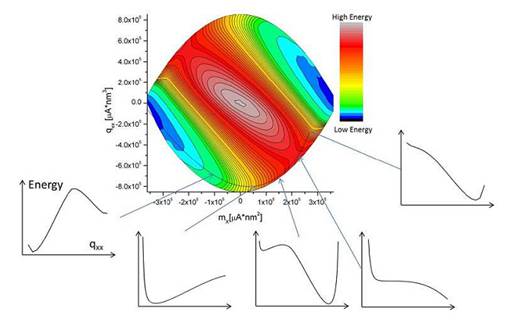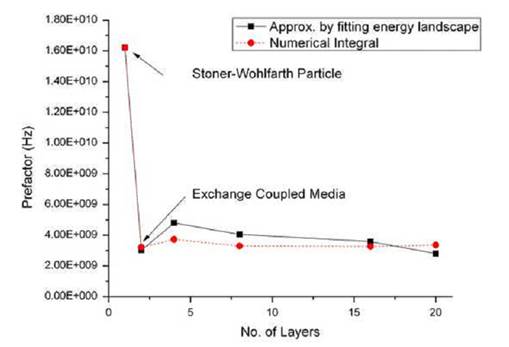Magnetic Storage
The density of magnetic recording is restricted by the superparamagnetic limit. To overcome this limit people have used perpendicular recording to replace the traditional longitudinal recording and are working on other approaches to get over the superparamagnetic limit including heat assisted recording, patterned media and exchange coupled media. Anisotropy graded media provides an alternative solution to achieve high areal density while keeping the writing field relatively low and good thermal stability. A two-dimensional energy landscape of the switching of anisotropy graded media is calculated to give an intuitive way of understanding the switching, as well as a way to quantitatively calculate the switching rate by mapping the problem onto a one-dimensional Langevin random walk. An iterative algorithm of for finding the saddle point of the energy landscape, which we call barbell algorithm, is used to locate the saddle point and the whole switching trajectory.

Fig. 1 Energy contour plot for anisotropy graded media, with insets showing cross-sections through it at constant Mx. Note that at the beginning of the switching process (on the left) there is a deep energy minimum, meaning that fluctuations about this configuration are small. Near the saddle point, this minimum becomes very shallow and disappears, indicating large fluctuations specifying such a value of mx does not determine the state of the system. (When there are two minima, we are interested in the left-hand one the other represents a reversed switching path at the top of the figure, related by Mx ↔ -Mx)

Fig. 2 Thermal switching rate prefactor as function of coarseness of discretization (number of layers). The data with black squares are obtained by parabolic fitting of the energy landscape. The red circles are obtained by direct numerical integral of the energy landscape. The switching rate prefactor of the Stoner-Wohlfarth particle (one layer) is obtained by analytical calculation of the energy landscape assuming that the energy barrier is the same as a 20-cell anisotropy-graded system.
Project participants: Ru Zhu, Graceland University

